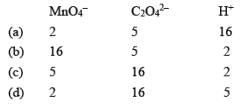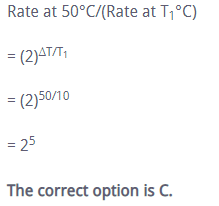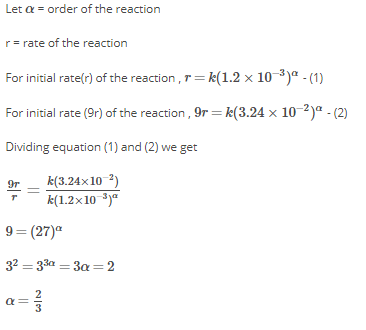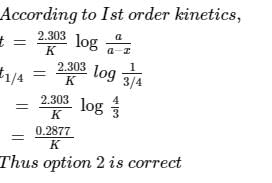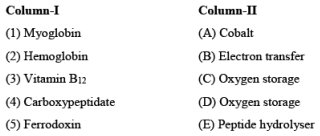SpA Test (14-10-2018) - Chemistry MCQ
30 Questions MCQ Test - SpA Test (14-10-2018)
The rate of a chemical reaction doubles for every 10°C rise of temperature. If the temperature is raised by 50°C, the rate of the reaction increases by about:
The rate of the reaction A → products, at the initial concentration of 3.24 × 10–2 M is nine times its rate at another initial concentration of 1.2 × 10–3 M. The order of the reaction is:
For the reaction  the value of rate of disappearance of N2O5 is given as 6.25 × 10–3mol L–1S–1. The rate of formation of NO2 and O2 is given respectively as:
the value of rate of disappearance of N2O5 is given as 6.25 × 10–3mol L–1S–1. The rate of formation of NO2 and O2 is given respectively as:
 the value of rate of disappearance of N2O5 is given as 6.25 × 10–3mol L–1S–1. The rate of formation of NO2 and O2 is given respectively as:
the value of rate of disappearance of N2O5 is given as 6.25 × 10–3mol L–1S–1. The rate of formation of NO2 and O2 is given respectively as:In the synthesis of ammonia by Haber process, if 60 moles of ammonia is obtained in one hour, then the rate of disappearance of Nitrogen is:
For a first order reaction A → P, the temperature (T) dependent rate constant (k) was found to follow the equation  The pre-exponential factor A and the activation energy Ea, respectively, are:
The pre-exponential factor A and the activation energy Ea, respectively, are:
The biological functions of the cytochrome P450 and myoglobin are, respectively:
A quantity of 0.50 mole of an ideal gas at 20°C expands isothermally against a constant pressure of 2.0 atm from 1.0 L to 5.0 L. Entropy change of the system is:
Given the molecular formula of the hexa coordinated complexes (A) CoCl3.6NH3 (B) CoCl3.5NH3 (C) CoCl3.4NH3. If the number of coordinated NH3 molecules in A, B and C respectively are 6, 5 and 4 the primary valency in (A), (B) and (C) are:
Which one of the following statement for order of reaction is not correct:
t1/4 can be taken as the time taken for the concentration of a reactant to drop to 3/4 of its initial value. If the rate constant for a first order reaction is K, the t1/4 can be written as:
The compound that undergoes decarboxylation most readily under mild condition is:
Consider the acidity of the carboxylic acids:
(I) PhCOOH
(II) o-NO2C6H4COOH
(III) p-NO2C6H4COOH
(IV) m-NO2C6H4COOH
Which of the following order is correct:
Starting with one mole of a compound A it is found that the reaction is 3/4th complete in one hour. If the reaction is first order, the rate constant is:
The diketone  on intramolecular aldol condensation gives the final product.
on intramolecular aldol condensation gives the final product.
Which of the following complex ions is expected to absorb visible light:
The crystal field stabilization energy (CFSE) is the highest for:
An optically active compound having molecular formula C8H16 on ozonolysis gives acetone as one of the products. The structure of the compound is:
The major organic product formed from the following reaction:

For the redox reaction

The correct coefficients of the reaction for the balanced reaction are:
